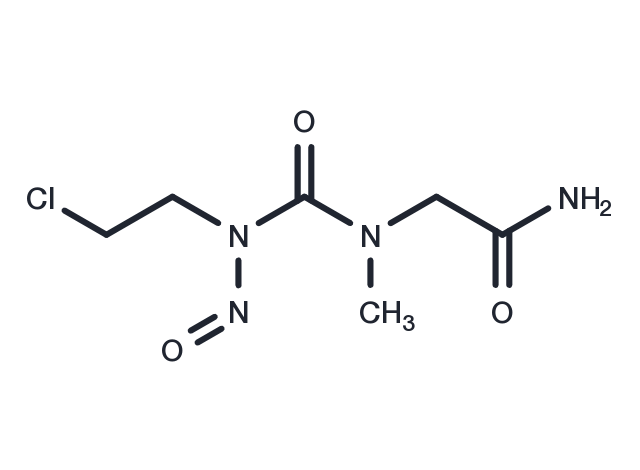Powder: -20°C for 3 years | In solvent: -80°C for 1 year


Sarmustine (SarCNU) is an alkylating agent with anticancer activity that inhibits the growth of prostate cancer cells via p53-dependent and p53-independent pathways.Sarmustine mediates the selection of P140K methylguanine-DNA-methyltransferase-transduced human CD34(+) cells in vitro.

| Pack Size | Availability | Price/USD | Quantity |
|---|---|---|---|
| 1 mg | In stock | $ 195.00 | |
| 5 mg | In stock | $ 483.00 | |
| 10 mg | In stock | $ 692.00 | |
| 25 mg | In stock | $ 1,080.00 | |
| 50 mg | In stock | $ 1,490.00 | |
| 100 mg | In stock | $ 1,970.00 |


| Description | Sarmustine (SarCNU) is an alkylating agent with anticancer activity that inhibits the growth of prostate cancer cells via p53-dependent and p53-independent pathways.Sarmustine mediates the selection of P140K methylguanine-DNA-methyltransferase-transduced human CD34(+) cells in vitro. |
| In vivo | Sarmustine (SarCNU) (s.c.) implanted SF-295 and U-251 central nervous system (CNS) tumor xenografts. When given i.v., q4d for 3 doses, to athymic mice bearing s.c. SF-295 tumors, SarCNU, at an optimum of 167 mg/kg/dose, produced 9 tumor-free animals of 10 total animals, 1 regression, and no evidence of overt toxicity (> or =20% body weight loss). Furthermore, SarCNU retained high antitumor activity at two lower dose levels, 66 and 45% of the optimal dose, whereas BCNU demonstrated a progressive loss of antitumor activity at lower doses. Following p.o. administration, SarCNU similarly demonstrated antitumor activity. In the U-251 CNS tumor model, SarCNU yielded six of six tumor-free animals at 80 mg/kg/dose with i.p. administration q.d. for 5 days, starting on day 14, whereas BCNU, at 9 mg/kg/dose, yielded three of six tumor-free mice and one drug-related death. Again, SarCNU resulted in tumor-free animals at 66 and 45% of its optimal dose and was relatively nontoxic. Results of testing to date indicate that SarCNU is clearly more effective than BCNU against the human CNS tumors SF-295 and U-251 in vivo. These results encourage the initiation of clinical trials for SarCNU, in an effort to improve therapeutic approaches to glioma.[3] |
| Synonyms | NSC-364432, SarCNU, Sarcosinamide, NSC 364432, NSC364432 |
| Molecular Weight | 222.63 |
| Formula | C6H11ClN4O3 |
| CAS No. | 81965-43-7 |
Powder: -20°C for 3 years | In solvent: -80°C for 1 year
DMSO: 50 mg/mL (224.59 mM)
You can also refer to dose conversion for different animals. More
bottom
Please see Inhibitor Handling Instructions for more frequently ask questions. Topics include: how to prepare stock solutions, how to store products, and cautions on cell-based assays & animal experiments, etc.
Sarmustine 81965-43-7 NSC-364432 SarCNU Sarcosinamide NSC 364432 NSC364432 inhibitor inhibit
